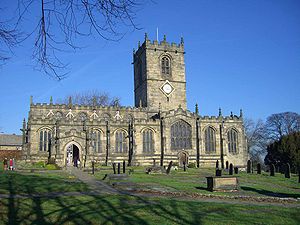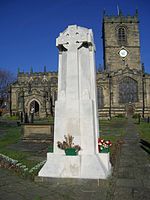- Church of St. Mary, Ecclesfield
-
The Church of St. Mary, Ecclesfield is situated on Church Street in the village of Ecclesfield, now a northern suburb of Sheffield, South Yorkshire, England. It is situated seven kilometres north of the city centre. It is a Grade One listed building, one of only five within the Sheffield city boundary. It was originally the parish church for Hallamshire, one of the largest parishes in England and in the 17th century was known as the “Minster of the Moors” due to its then rural situation.
Contents
History
The exact date for the creation of a church on the site of St. Mary’s is unknown. The name Ecclefield, which may mean “Church in the Field” in the Old English language, is mentioned in the Domesday Book (though the church is not[1]), so it is possible that there might have been some sort of place of worship there before the Norman conquest of England. It has been implied by historians that the Anglo-Saxons founded a church on the site between 625 and 650.
After the conquest and the repercussions of the Harrying of the North the lands around Ecclesfield passed to William de Lovetot at the start of the 12th century. It was de Lovetot who built the first substantial church on the site, with a date of 1111 often given, however there is no written evidence to support this date. The church was given to the monks of Fontenelle Abbey, near Rouen, Normandy becoming an “alien priory”, a small group of monks came from France to live there. In 1386 Richard II dissolved the alien priories and handed over the church to the Carthusian Monks of Coventry who held it until the Dissolution of the Monasteries in the late 1530s, when it was handed over to the Lords of Hallamshire.
Construction of the present day church began in 1478 and was completed around 1500, being built in the perpendicular style. Under Puritans influence in the 1640s many of the church’s decorative pieces and all the stained glass was smashed after a 1643 Act of Parliament that stated "all representations of any angel or saint in any…parish church…was to be taken away, defaced and utterly demolished." Some of the surviving glass from the windows was pieced together and put into windows in the north aisle and vestry. The 18th and 19th centuries saw much re-ordering in the church especially to the nave and chancel under the respective vicars William Ryder and Alfred Gatty.[2][3][4]
In 1878, a football club representing Ecclesfield Church joined the Sheffield Football Association.
Present day
The 42nd Vicar of Ecclesfield is Revd. Daniel Hartley who was installed as vicar by the Bishop of Sheffield, Rt. Revd. Dr. Steven Croft, on 23 January 2011. A Yorkshireman, Daniel has spent the past 7 years based in Barnard Castle where he was chaplain to the HM Young Offenders Institution at Deerbolt. The church is built of local stone and has an octagonal font. The pulpit dates from 1876 with four panels carved with scenes from St. Pauls life, the lectern was installed at the same time. Since WWII, both the chancel and the nave have been given new roofs. The tower contains a peal of eight bells, two of which date from the 17th century. Music in the church is provided by a pipe organ. The church yard contains a war memorial made from light coloured stone, it was designed by R.B. Brookgreaves and has the names of 54 local people engraved on it who have given their lives in conflicts.[5]
A carved cross shaft lies inside the church. It is around five feet high and lies in a double base. In the churchyard is a sundial mounted on a base with what may be an ancient lower part.[6]
References
- ^ Eastwood, Jonathan (1862). "Chapter IV: The Church". History of the Parish of Ecclesfield. London: Bell and Daldy.
- ^ www.stmarysecclesfield.com. Gives church history.
- ^ British History Online. Gives church history.
- ^ www.spick.co.uk. Gives church history.
- ^ www.stmarysecclesfield.com. Gives details of present day church.
- ^ Neville T. Sharpe, Crosses of the Peak District (Landmark Collectors Library, 2002)
External links
Churches in Sheffield Cathedrals Pre-19th century All Saints, Ecclesall · Attercliffe Chapel · Beauchief Abbey · St James, Midhopestones · St James, Norton · St Mary, Bolsterstone · St Mary, Ecclesfield · St Mary the Virgin, Beighton · St Mary, Handsworth · St Nicholas, Bradfield · St Paul, Pinstone StreetCommissioners' churches Christ Church, Pitsmoor · Christ Church, Stannington · St George, Portobello · St Mary, Bramall Lane · St Matthew, Carver Street · St Thomas, BrightsideNon-conformist chapels Other churches Hillsborough Trinity · Sacred Heart, Hillsborough · St John, Ranmoor · St Mark, Broomhill · St Mark, Grenoside · St Paul, Norton Lees · St Peter, Greenhill · St Paul, Wordsworth Avenue · St Thomas, Crookes · St Vincent, Solly Street · WadsleyListed buildings in Sheffield Grade I Abbeydale Industrial Hamlet Works • St Mary, Ecclesfield • St Nicholas, Bradfield • Sheffield Cathedral • Town HallGrade II* Abbeydale Industrial Hamlet Housing • Arts Tower and Library • Beauchief Abbey • Beauchief Hall • Beehive Works • Bishops' House • Butchers Wheel • City Hall • Cornish Place • Cutlers' Hall • Ecclesfield Priory • Endcliffe Hall • Fair House Farmhouse • General Cemetery • Globe Works • Green Lane Works Gateway • Heritage House • King Edward VII Upper School • Leah's Yard • Little Matlock Rolling Mill • Lyceum Theatre • Manor Lodge Turret House • Mappin Art Gallery • The Mount • Mount Pleasant • Norton Hall Hospital • Oakes Park • Old Queen's Head • Onesacre Hall • Paradise Square • Park Hill Flats • St James, Midhopestones • St James, Norton • St Mary, Bramall Lane • St Mary the Virgin, Beighton • St Paul, Wordsworth Avenue • Sanderson Kayer's Darnall Works • Sharrow Mills • Victoria Quays Terminal Warehouse • Well Meadow Street Crucible Furnace • Whitley Hall Hotel • Wicker ArchesLists City Centre • S2 • S3 • S4 • S5 • S6 • S7 • S8 • S9 • S10 • S11 • S12 • S13 • S14 • S17 • S20Categories:- Buildings and structures in Sheffield
- Churches in Sheffield
- Church of England churches in South Yorkshire
- History of Sheffield
- Ecclesfield
- 1470s architecture
- Grade I listed churches
- Grade I listed buildings in South Yorkshire
- 12th-century church buildings
Wikimedia Foundation. 2010.


